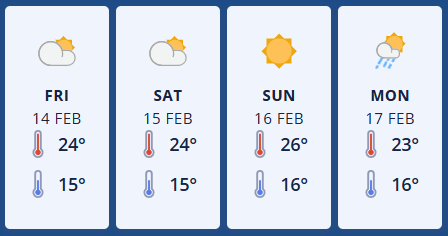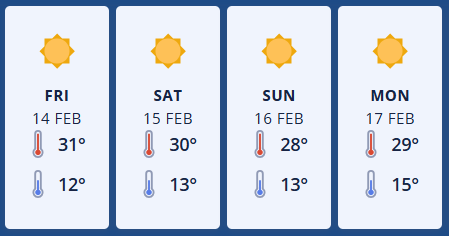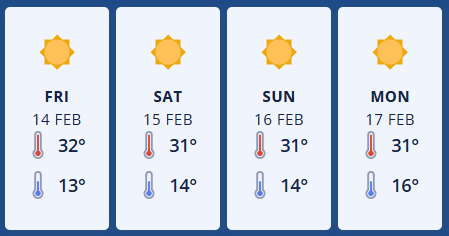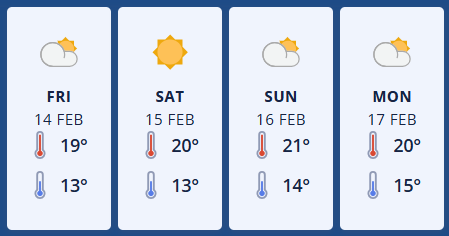Otago Weekly Fishing Report - 13 February 2025
- Otago
- 13/02/2025

Fine outlook for fishing
Fishing conditions look tantalising for the next few days with most rivers running clear, creating excellent sight fishing opportunities, and an abundance of terrestrial insects.
Tim Halter with a brown trout that went aerobatic after rising to a well-presented cicada pattern on one of Wānaka’s large tributaries. Credit: Mason Court.
Last week’s rain never developed beyond a light drizzle in the headwaters, leaving many rivers with low flows. With more warm and calm weather forecast for the weekend, expect flows to continue decreasing and water temperatures to rise.
Lake Wānaka is feeling the effects of the dry conditions, sitting nearly a metre below its median level. However, low lake levels aren’t all bad — they can expose more shoreline for anglers and make deep drop-offs near river mouths more accessible. Boaters are urged to take extra care, as previously submerged hazards may now be exposed and pose navigation risks.
Anglers should take care to land fish quickly and release them with minimal handling to avoid prolonged stress, especially in the warmer shallows. If intending to keep fish for the table, don’t forget your ice.
Off the top

Use this one, Dad! Matila (left) selecting her fly of choice for a rising rainbow, and (right) the results speak for themselves with a lovely rainbow trout in the net. Credit: Jakub Kanok.
A family outing up one of Lake Wakatipu’s many tributaries last week proved successful for Otago honorary ranger Jakub Kanok and his daughter Matilda, with rainbow trout rising from the depths to smash terrestrial fly patterns.
Rainbow trout were often seen holding mid-water or near the surface, clearly keyed in on cicadas, grasshoppers, and green beetles being deposited onto the river. As an angler, few sights get the heart pumping more than a pair of jaws breaking the surface to inhale an insect.
Jakub noted that as the day progressed, rainbows moved into faster water and runs, often leading to explosive dry fly takes. While these fish were actively feeding, they could also be a little skittish. Jakub recommends making a few practice casts blind into likely water to shake off any rust and be prepared when a fish is spotted — all while covering more water.
Sea-run trout

This sea-run brown trout (insert) took a soft-plastic smelt imitation in the tidal zone of the Catlins River. Credit: Bruce Quirey.
Sea-run brown trout are prized targets in Otago estuaries during the warmer months.
These spotted silver bullets are the same species as those caught in freshwater but fight hard and taste great. The stomach contents of the trout in the above picture, from the Catlins River last week, included crabs but they also dine on smelt, bullies and whitebait.
- Sea-run trout often follow baitfish into river mouths as the tide pushes in. The last two hours of the incoming tide and the first hour of the outgoing tide are prime times. Early morning and late evening are also productive, as trout feed more actively in low light.
- Look for rocky outcrops, submerged logs, and underwater drop-offs where shallow flats meet deeper channels, especially where tidal currents create eddies, as trout ambush prey in these areas.
- Natural-coloured soft plastics in smelt, pearl, or silver colours imitate the whitebait and small baitfish sea-run trout feed on. Yellow or chartreuse are also effective.
- Match the prey size. For soft plastics, try a 3-4 inch paddle tail rigged on a 1/8 to 1/4 oz jighead.
- Shallow-diving minnow-style lures in whitebait or silver patterns are excellent for covering water. Traditional spinners like the Toby (10-14g in silver/blue) or black and gold Tasmanian Devil also get results.
- A 6-10 lb fluorocarbon leader helps avoid spooking fish in clear water.
- Start with a steady retrieve but mix in occasional pauses or twitches to trigger strikes.
Lake Hāwea Family Fishing Classic
Challenging weather was the name of the game last Saturday on Lake Hāwea, as over 400 keen anglers — mostly young families — gathered for the annual Lake Hāwea Family Fishing Classic, chasing the lake’s trio of sportsfish: brown trout, rainbow trout, and salmon.
The morning offered calm conditions, but by the afternoon strong winds swept across the lake, creating waves and whitecaps. Many brave but seasick children sought shelter in calmer areas or returned to the safety of the boat ramp.
Despite the challenging conditions, some impressive fish were landed. Bill Dixon took home the prize for the heaviest fish with a 2.256kg rainbow trout. Sandra Stuart won the women’s category with a 1.76kg catch, Trey Whitu claimed victory in the junior division with a 1.956kg fish, and Hadley Templeton secured the win in the child division. Full results can be found on the Lake Hāwea Family Fishing Classic Facebook page.
Anglers reported fish being caught throughout the lake, with cruising brown trout successfully taken on soft baits and flies along the edges. However, the most productive methods remained the tried-and-true deep-water tactics using downriggers, lead lines, or paravanes.
With another exciting competition wrapped up, families are already looking forward to next year’s event!
Central Lakes acoustic surveys
Staff completing acoustic surveys earlier this week up Stevensons Arm on Lake Wānaka. Note the extended pole which has the larger-than-normal transporter mounted on it. Credit: Mason Court.
If you’ve recently spotted the Otago Fish & Game vessel OFG7 zigzagging along the edges of the larger lakes, don’t worry — our steering isn’t broken! This week we’re conducting acoustic monitoring of fish populations in Lakes Wakatipu, Wānaka and Hāwea.
This marks the third consecutive year of this survey, helping to establish a valuable baseline for future comparisons. Using a high-tech echo sounder, staff are collecting vast amounts of data, which will be analysed and reported to the Otago Fish & Game Council in the coming months.
The Council has made it a strategic priority to understand the drivers behind changes in trout and salmon populations and to establish long-term monitoring for the Southern Lakes fisheries.
To read last year’s report, click here.
Don’t forget about perch

Simon Connell with a perch caught spin fishing off the Lake Waihola boardwalk. Please take care when fishing here to avoid our boardwalk users. Credit: Jayde Couper.
With warm water temperatures and low flows, now is a great time to give spooky, shallow-water trout a break until we get some rain — and instead, turn your attention to perch. Perch have been highly active in recent weeks, thriving in the warm water conditions. These fish are relatively easy to catch, and their firm, white flesh makes for excellent eating.
Brightly coloured soft plastics are particularly effective, but perch also readily take spinners, natural baits like worms and maggots, as well as feathered lures and nymphs. Many anglers swear by red lures, with small blade spinners such as Mepps, as well as Rapalas and Zeds, being popular choices.
Several locations hold strong perch populations, including but not limited to:
- Coastal Otago: Lake Waihola, the lower Taieri and Clutha rivers, and Tomahawk Lagoon.
- Central Otago: Butchers Dam, Conroys Dam near Alexandra, the Manuherekia River, and Fraser Dam near Clyde.
- Queenstown area: Lake Hayes and Lake Johnson.
Perch are often found near underwater structures or snags, and they tend to swim in small schools—so if they start biting, stay put!
Take care when handling perch, as they have several sharp spines, including one on each gill cover.
Tussock lakes
Fish & Game rangers patrolled Loganburn Dam last Saturday, checking 25 licence holders with a pleasing 100% compliance rate.
- Loganburn Reservoir is low so if boating be careful of shallow water at the southern end of the lake.
- The surface water temp during the day was 19-20 degC, so fish will be down deep. Fish early mornings and late evenings if possible.
- Cicadas were seen on the water but no fish rising to them. Seagulls were having a field day.
- When fishing with a cicada pattern, don’t stand in one spot all day. Keep moving. Fish for five minutes, then move 15 metres, fish for five minutes, then move again. You will encounter more fish using this method.
- There is a patch of fine weather for the next three days. This could be the last chance for a cicada hatch, so hit the big four tussock lakes - Loganburn, Manorburn, and Poolburn dams and Lake Onslow.
Vale Brian Turner
Brian Turner, ONZM. Credit: Stephen Jaquiery, ODT.
Otago Fish & Game representatives joined a crowd gathered at a memorial service to honour Brian Turner at his home in Oturehua yesterday.
Turner was a highly respected New Zealand poet, author, environmentalist, and angler with deep ties to this region’s landscapes and waterways. His lifelong passion for the outdoors, particularly fishing, conservation, and advocacy for New Zealand’s rivers and wild places, made him an influential figure in the environmental and sporting community. Turner, a past Otago Acclimatisation Society member and Otago Fish & Game Councillor, died peacefully on February 5.
Read more on our Facebook page
Clyde Dam live webcam

A screengrab of the Clyde Dam webcam taken at the time of writing.
Want to know conditions at Clyde Dam? Check this live webcam sponsored by Contact Energy updated every 15 minutes.
Lake Wānaka live webcam

A screengrab of the Lake Wānaka webcam taken at the time of writing.
Want to know conditions at Lake Wānaka? Check this live webcam from the Wānaka water sports facility.
Here’s the weekend outlook:
Dunedin

Making the most of the calm mornings will be key for anglers around Dunedin this weekend, with excellent fishing conditions expected before the wind picks up in the afternoons on Saturday and Sunday.
With the Taieri River running low and warm, anglers may have better success targeting deeper, cooler waters or switching focus to a different quarry, such as perch.
The Taieri River at Outram was flowing at 3.75 cumecs at the time of writing. The water temperature was 18.1 degrees C.
Click here for live weather updates.
Wānaka

A scorcher of a weekend is forecast for Wānaka, making it perfect for heading into the backcountry or taking the boat out on the lake. With air temperatures expected to reach 30 degC, expect fish to respond by seeking deeper, cooler water.
Northerly winds are forecast to develop each evening, which may help bring terrestrial insects onto the water — something to keep in mind for late-day fishing.
Click here for live weather updates.
Alexandra

Don’t forget plenty of sunblock and water if you're heading out fishing around Alexandra this weekend with temperatures soaring into the early 30s and limited wind. These conditions are perfect for fishing the local reservoirs and targeting cicada-feeding fish.
Northerlies developing later in the day may help blow cicadas onto the water — move around to use the wind to your advantage to help your backcast if needed.
Click here for live weather updates.
Clutha Regional Forecast

Saturday looks to be ideal to fish the lower Clutha/Mata-Au with calm conditions, low flows, and minimal wind. However, the low flows and warm water on the Pomahaka may make fishing tricky. Isolated showers on Sunday could offer some relief and refresh smaller waterways.
The Pomahaka River was flowing at 3.86 cumecs.
The lower Clutha River at Balclutha was flowing at 288 cumecs.
Click here for live weather updates.
For more ORC water monitoring and alerts information click here.
Grab your licence online and let the angling adventures begin.
Got any Otago fishing news?
Send your fishing news and photos (with anglers’ names) to otago@fishandgame.org.nz for consideration in the weekly report.